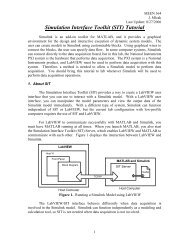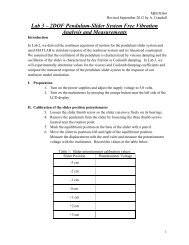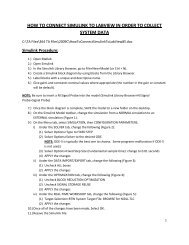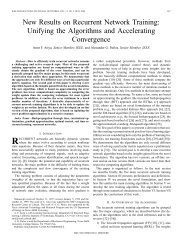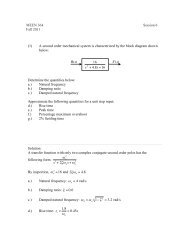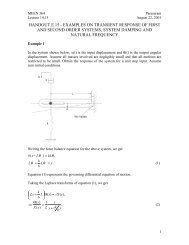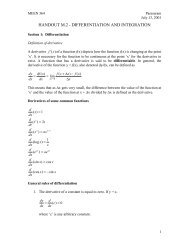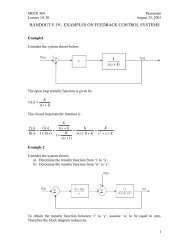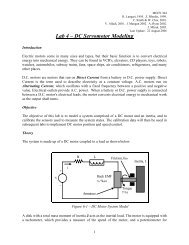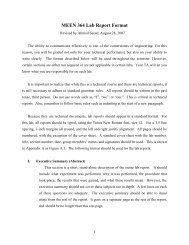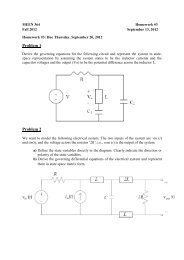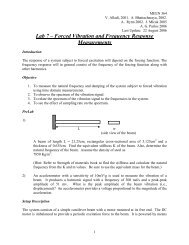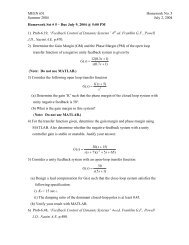KIM et al.: SENSORLESS FAULT DIAGNOSIS OF INDUCTION MOTORS 1045TABLE IIMOTOR PREDICTOR ACCURACY FOR SMALL AND LARGE MACHINESthe fundamental <strong>of</strong> the residual signals, whereas the second indicator,used for mechanical <strong>fault</strong> detection, is the rms value <strong>of</strong>the normalized harmonics component <strong>of</strong> the residual signal.Consider the time interval during which themotor measurements and the residuals are obtained. If thequasi-steady-state mode is considered, then this is assumedto contain stationary motor measurements. The three phasecurrents , , and , and residuals ,, and can be expressed asthe three-phase residual signals, computed by applying the FFTalgorithm on the signals , , .For the transient mode <strong>of</strong> operation, the residual signals arecharacterized by time-varying fundamental magnitude. As such,if properly computed, the associated negative sequence will bea time-varying signal. The negative sequence <strong>of</strong> the residuals,, is computed using the following modified form <strong>of</strong> thesymmetrical component theory as(14)(15)where the superscript is replaced by either “ ”or“ ” fornonstationary or quasi-stationary, respectively, the subscriptstands for any one <strong>of</strong> the three phases “ , ,or ,” and whereand are the “fundamental” and “harmonics” components <strong>of</strong>the signals.1) Electrical Fault Indicator: Assuming quasi-steady-statemotor operation, let the size <strong>of</strong> a moving window within thesegment be , and the moving distance <strong>of</strong> thewindow be . Then, the negative sequence <strong>of</strong> the residualsignal, , can be computed using the symmetrical componenttheory as(16)where and , and where ,, are the magnitudes <strong>of</strong> the fundamental components <strong>of</strong>(17)where (15) is used in the definition <strong>of</strong> the residuals. The timevaryingfundamental component <strong>of</strong> the residual signals is calculatedusing wavelet packet decomposition and it reflects thetime-varying nature <strong>of</strong> the negative-sequence signal.2) Mechanical Fault Indicator: The <strong>fault</strong> indicator proposedin this study for detecting mechanical <strong>fault</strong>s, and inparticular bearing and rotor <strong>fault</strong>s, is based on the observationthat the motor currents, and as a result the residuals, aredistorted in the presence <strong>of</strong> such <strong>fault</strong>s. Consequently, in thepresence <strong>of</strong> such mechanical <strong>fault</strong>s the harmonic componentsin the residuals increase when compared to a baseline. Currentharmonics variations provide some clues for detecting thepresence <strong>of</strong> mechanical <strong>fault</strong>s, whereas tracking variations inthe motor current fundamental might result in false alarms.Relative changes in the harmonics, as seen through the processing<strong>of</strong> the residuals, appears promising for the detection <strong>of</strong>changes in motor mechanical condition.In the quasi-steady-state operating mode, the frequency components<strong>of</strong> the residuals and the motor current are separatedusing the FFT algorithm, and a moving window rms value <strong>of</strong> theharmonic components <strong>of</strong> the residual and current signals can becomputed. In the transient operating mode, this decompositionis performed using wavelet packet analysis. As in the case <strong>of</strong>Indicator 1, let the size <strong>of</strong> a moving window within the segment
1046 IEEE TRANSACTIONS ON INDUSTRIAL ELECTRONICS, VOL. 50, NO. 5, OCTOBER 2003Fig. 6. Impact <strong>of</strong> speed estimation for 2.2-kW healthy motor; current residual generated by measured speed and estimated speed (top), Indicator 1 (middle), andIndicator 2 (bottom).be , and the moving distance <strong>of</strong> the window be .The two moving window rms values are computed as(18)(19)where and where the superscript is replacedby either “ ”or“ ” for nonstationary or quasi-stationary, respectively.Since the signatures resulting from mechanical <strong>fault</strong>sare equally contained in all three motor currents, andcan be computed for any one <strong>of</strong> the three phases.The relative change in the harmonics component<strong>of</strong> the residual signal can be quantified by the ratio. In this study, the normalized harmonicscontent <strong>of</strong> the residuals, , is used as an indicatorfor detecting mechanical <strong>fault</strong>s, as follows:(20)3) Signal Segmentation Algorithm: The signal segmentationalgorithm separates the nonstationary motor measurementsinto a set <strong>of</strong> quasi-stationary signals. The segmentation ismotivated by the fact that for the motor measurements to beconsidered stationary, not only their fundamental componentsbut also their harmonic components must remain time invariantwithin a certain range <strong>of</strong> magnitude. Thus, it is required toinvestigate the variations <strong>of</strong> the harmonic and fundamentalcomponents <strong>of</strong> the motor measurements as a function <strong>of</strong> time,using a fine frequency resolution. In this research, the signalsegmentation is performed using the wavelet packet transform.A nonstationary signal containing multifrequency componentscan be decomposed into a number <strong>of</strong> signals having the correspondingfrequency by using the wavelet packet algorithm. Thedecomposed signals for each frequency components are examinedand the time variation <strong>of</strong> their magnitude is compared to apreselected threshold. This user-specified threshold representsthe allowed magnitude variations in order for a signal to beconsidered stationary [19].V. MOTOR FAULT DETECTION AND DIAGNOSIS EXPERIMENTSA. Experimental Setups and Staged Motor FaultsA four-pole 2.2-kW <strong>induction</strong> motor testbed is run directly<strong>of</strong>f the supply mains at 60 Hz. This is the small machinetest bed. The motor has 324 stator turns and 44 rotor bars and itis connected to two dc generators in series. The first dc generator



